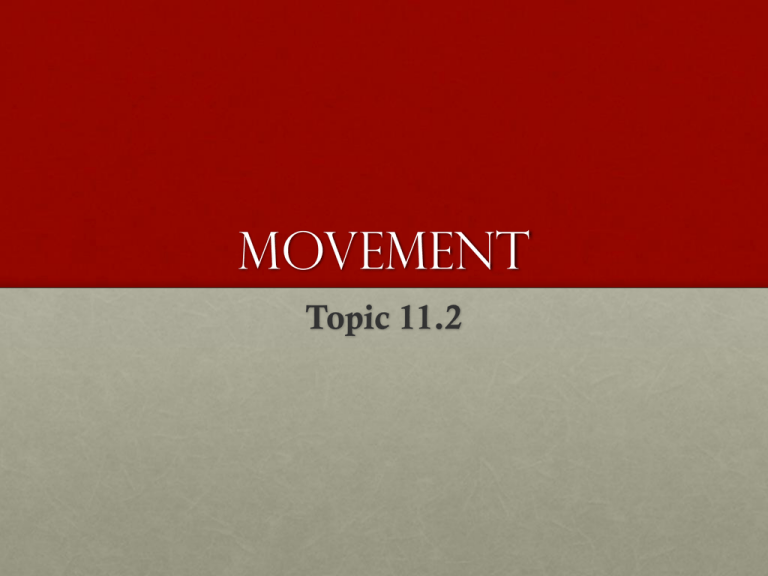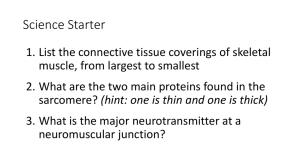Skeletal Muscle Structure
advertisement

Movement Topic 11.2 Assessment Statements 11.2 U1 Bones and exoskeletons provide anchorage for muscles and act as levers. 11.2 U2 Synovial joints allow certain movements but not others. 11.2 S2 Annotation of a diagram of the human elbow. 11.2 U3 Movement of the body requires muscles to work in antagonistic pairs. 11.2 A1 Antagonistic pairs of muscles in an insect leg. Role of bones and Exoskeleton Leverage Bones act as levers A lever is a rigid rod that rotates around a fixed point (fulcrum) effort Force applied to the lever is called effort Force that resists motion is called the load. fulcrum lever Levers in our body Joints act as fulcrums L E Synovial joints Movements of joints Rotation AnTagonistic Pairs Assessment Statements 11.2 U4 11.2 U5 11.2 U6 11.2 U7 11.2 U8 11.2 U9 11.2 S3 11.2 S4 Skeletal muscle fibers are multinucleate and contain specialized endoplasmic reticulum. Muscle fibers contain many myofibrils. Each myofibril is made up of contractile sarcomeres. The contraction of the skeletal muscle is achieved by the sliding of actin and myosin filaments. ATP hydrolysis and cross bridge formation are necessary for the filaments to slide. Calcium ions and the proteins tropomyosin and troponin control muscle contractions. Drawing labeled diagrams of the structure of a sarcomere. Analysis of electron micrographs to find the state of Skeletal Muscle Skeletal Muscle • Muscle tissue is made of muscle fibers • A muscle fiber is a large cell that contains many nuclei • Inside each muscle fiber are numerous myofibrils • Each myofibril is surrounded by a special endoplasmic reticulum called a sarcoplasmic reticulum. • Between myofibrils many mitochondria are found • Each myofibril is composed of repeating units called sarcomeres. • Each sarcomere is composed of actin and myosin filaments. Skeletal Muscle Sarcolema = plasma membrane Sarcoplasmic Reticulum = Endoplasmic Reticulum • goes around every myofibril • Stores calcium Muscle fibers contain myofibrils Actin ( thin filaments) Myosin (thick filaments) tutorial on sarcomere components sarcomere How does skeletal muscle contract? Sliding Filament Hypothesis: (1950 – H. Huxley & J. Hanson – London) • If muscle fibers slide then band pattern should change during contraction. • Light bands would become shorter • Sarcomere would become shorter • Dark bands would stay the same length Relaxed and Contracted muscle The size of the light area indicates contracting or relaxing Sliding filament theory: Myosin has side branches with heads that create a bridge to the actin filament • ATP binds to the myosin head breaking the bridge and changing the head position releasing it from the actin • The ATP hydrolyzes into ADP & Phosphate. This causes the head to attach to the actin at a specific binding site • As the ADP and phosphate are released the head bends & the actin filament is pulled toward the center • Sliding filament theory: Role of Calcium • Calcium is very important in the contraction process. • The influx of Ca+ is stimulated by the nerve impulse • The sarcoplasmic reticulum releases Ca+ • An influx of Ca+ causes opening of myosin binding sites on the actin filament. • This allows contraction to occur. • When Ca+ concentration decreases the binding sites close and the muscle relaxes How movement Occurs animation of the actin myosin mechanism to create movement How Movement Occurs: Watch the animation from the Campbell CD on Muscle Contraction How movement Occurs Click the link below to watch this simulation of how a muscle works. Muscle Contraction simulation








